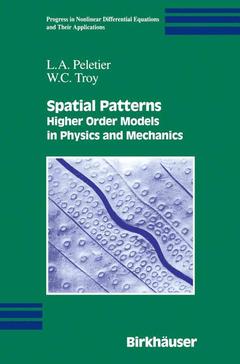Description
Spatial Patterns, Softcover reprint of the original 1st ed. 2001
Higher Order Models in Physics and Mechanics
Progress in Nonlinear Differential Equations and Their Applications Series, Vol. 45
Authors: Peletier L.A., Troy W.C.
Language: English
Spatial Patterns
Publication date: 10-2012
343 p. · 15.5x23.5 cm · Paperback
Publication date: 10-2012
343 p. · 15.5x23.5 cm · Paperback
Spatial Patterns
Publication date: 06-2001
343 p. · 15.5x23.5 cm · Hardback
Publication date: 06-2001
343 p. · 15.5x23.5 cm · Hardback
Description
/li>Contents
/li>
The study of spatial patterns in extended systems, and their evolution with time, poses challenging questions for physicists and mathematicians alike. Waves on water, pulses in optical fibers, periodic structures in alloys, folds in rock formations, and cloud patterns in the sky: patterns are omnipresent in the world around us. Their variety and complexity make them a rich area of study. In the study of these phenomena an important role is played by well-chosen model equations, which are often simpler than the full equations describing the physical or biological system, but still capture its essential features. Through a thorough analysis of these model equations one hopes to glean a better under standing of the underlying mechanisms that are responsible for the formation and evolution of complex patterns. Classical model equations have typically been second-order partial differential equations. As an example we mention the widely studied Fisher-Kolmogorov or Allen-Cahn equation, originally proposed in 1937 as a model for the interaction of dispersal and fitness in biological populations. As another example we mention the Burgers equation, proposed in 1939 to study the interaction of diffusion and nonlinear convection in an attempt to understand the phenomenon of turbulence. Both of these are nonlinear second-order diffusion equations.
1 Introduction.- 1.1 Model equations.- 1.2 The Fisher–Kolmogorov equation.- 1.3 An overview.- 1.4 Methods.- 1.5 About the presentation.- 1.6 Bibliographical notes.- I The Symmetric Bistable Equation.- 2 Real Eigenvalues.- 3 Estimates.- 4 Periodic Solutions.- 5 Kinks and Pulses.- 6 Chaotic Solutions.- 7 Variational Problems.- II Related Equations.- 8 The Asymmetric Double-Well Potential.- 9 The Swift–Hohenberg Equation.- 10 Waves in Nonlinearly Supported Beams.- References.
© 2024 LAVOISIER S.A.S.
These books may interest you

The Painlevé Handbook 98.58 €



